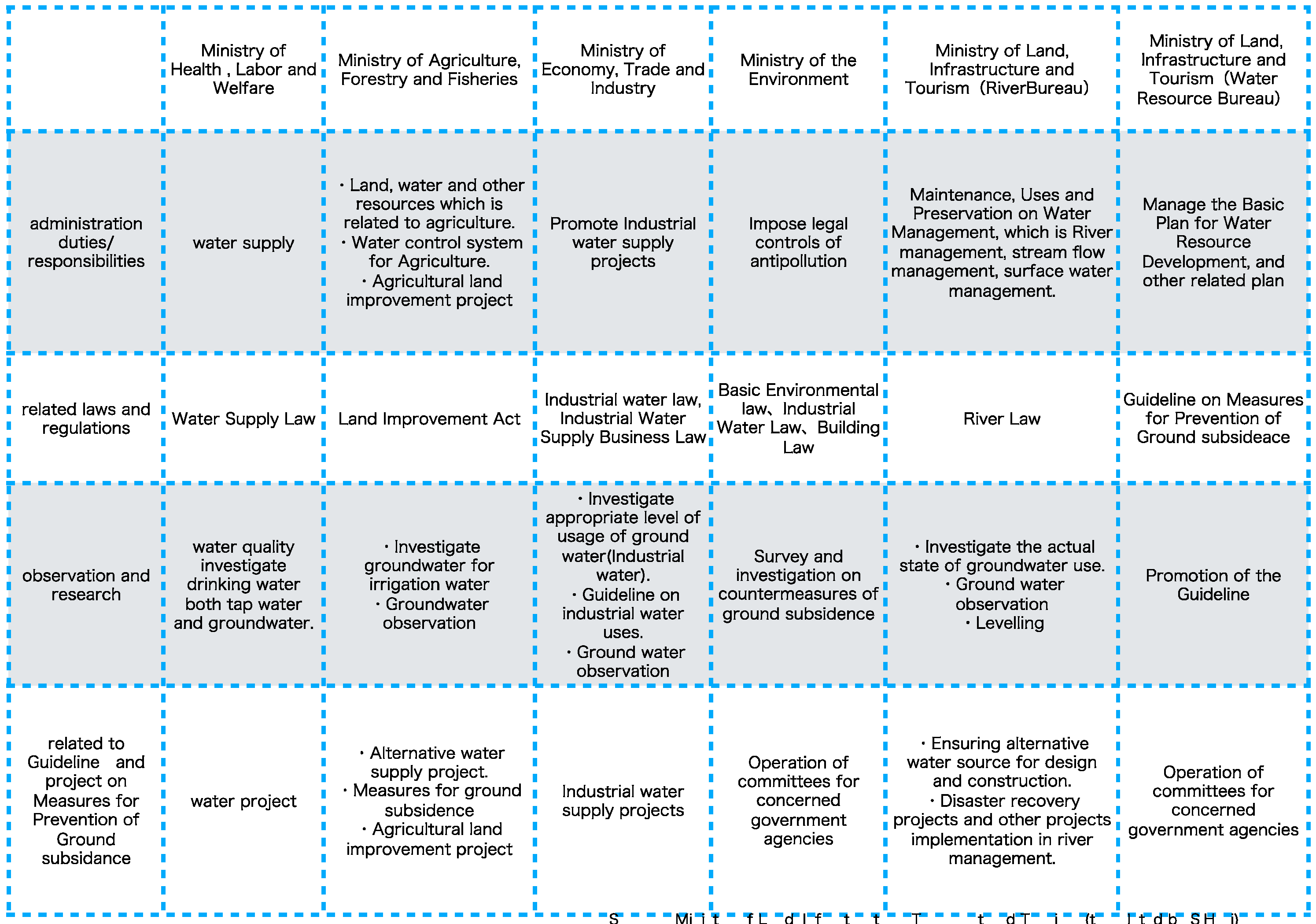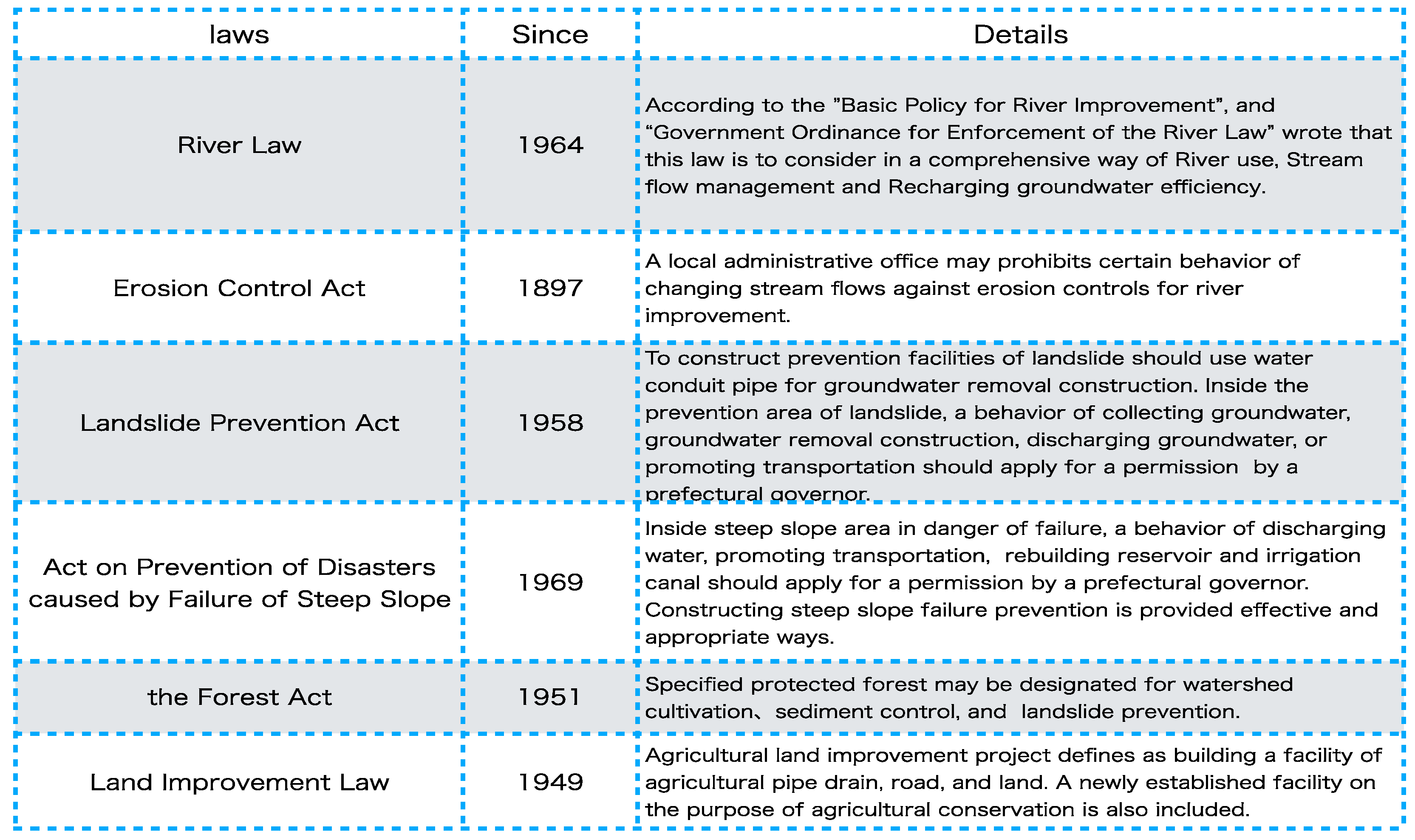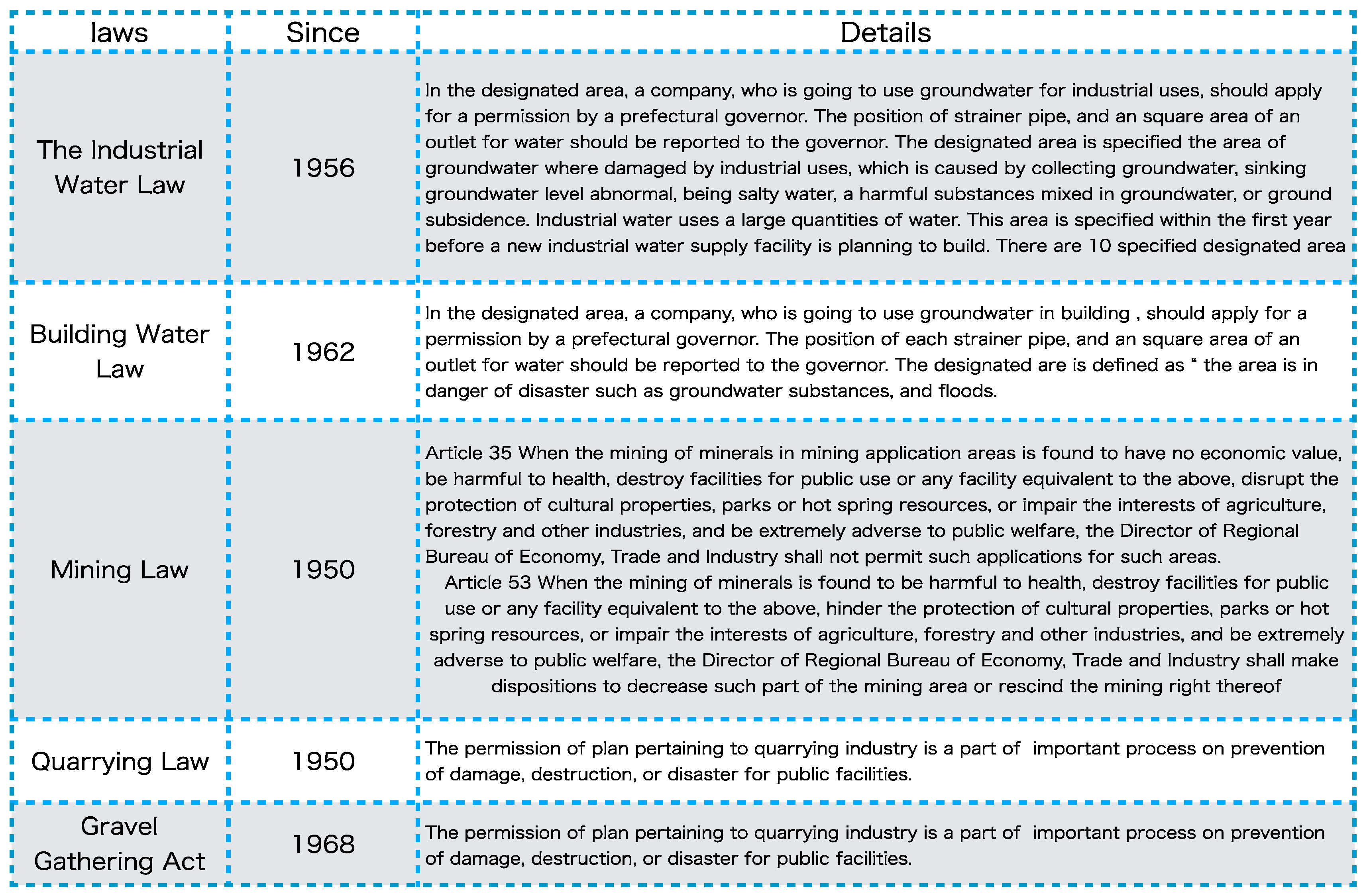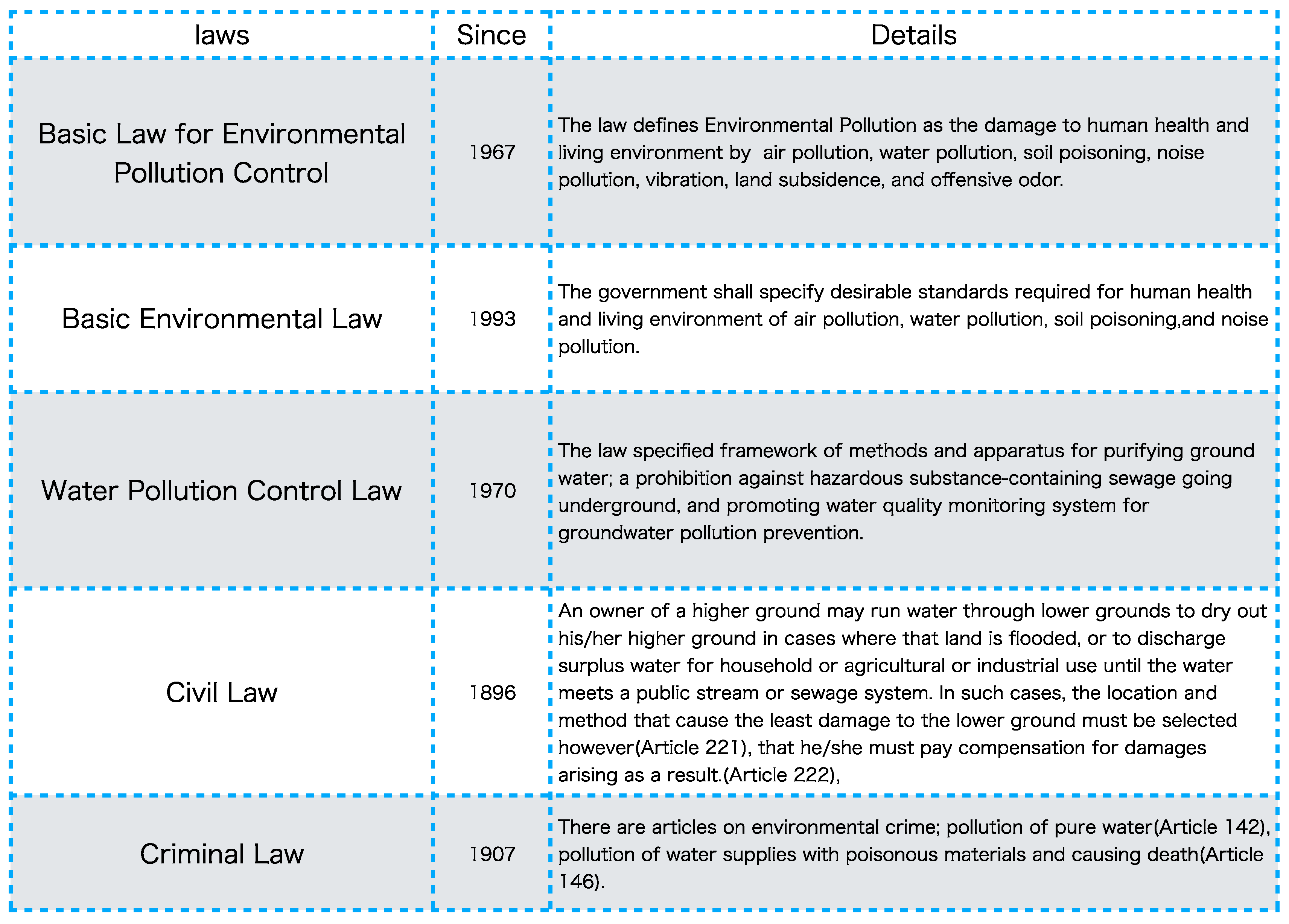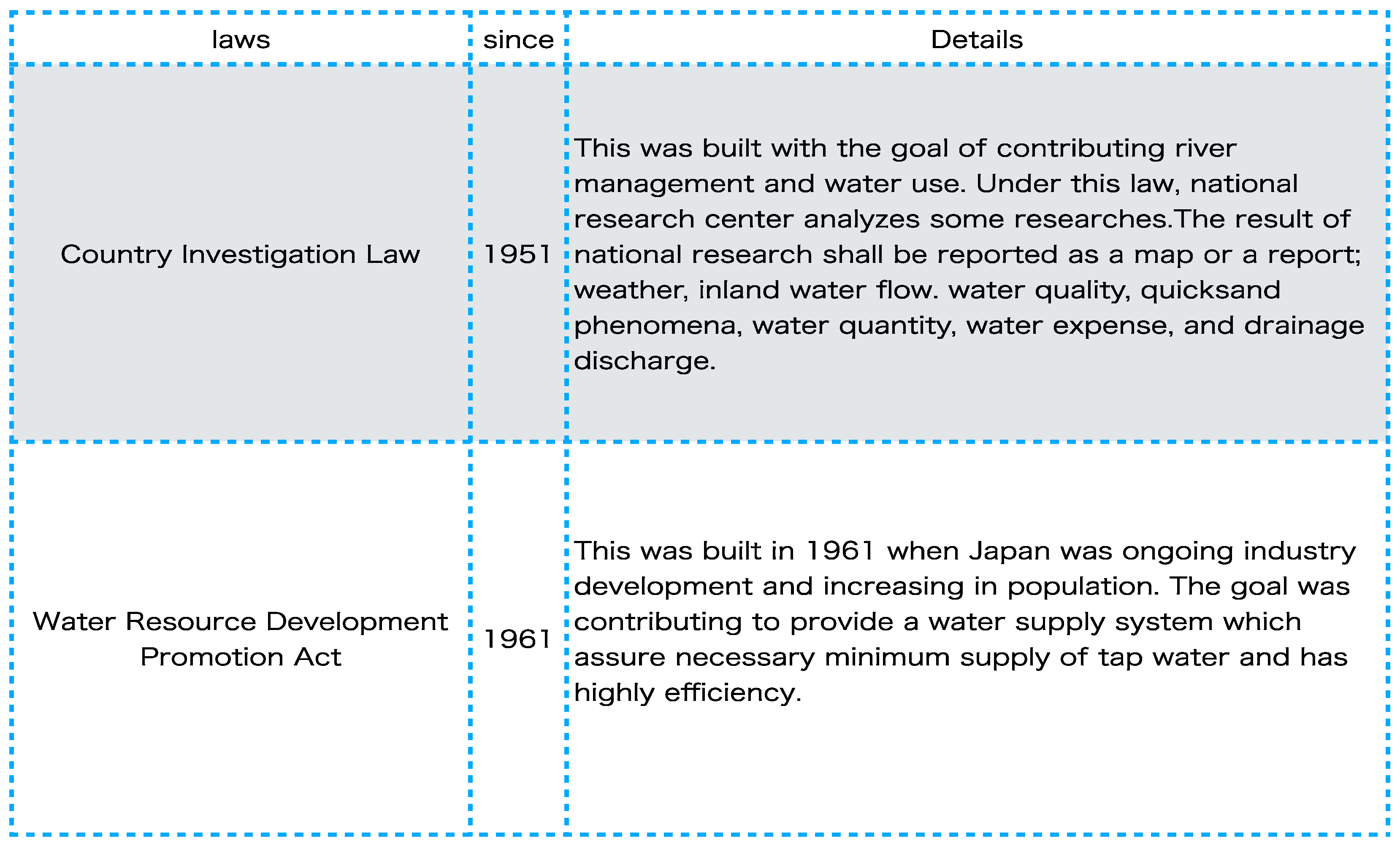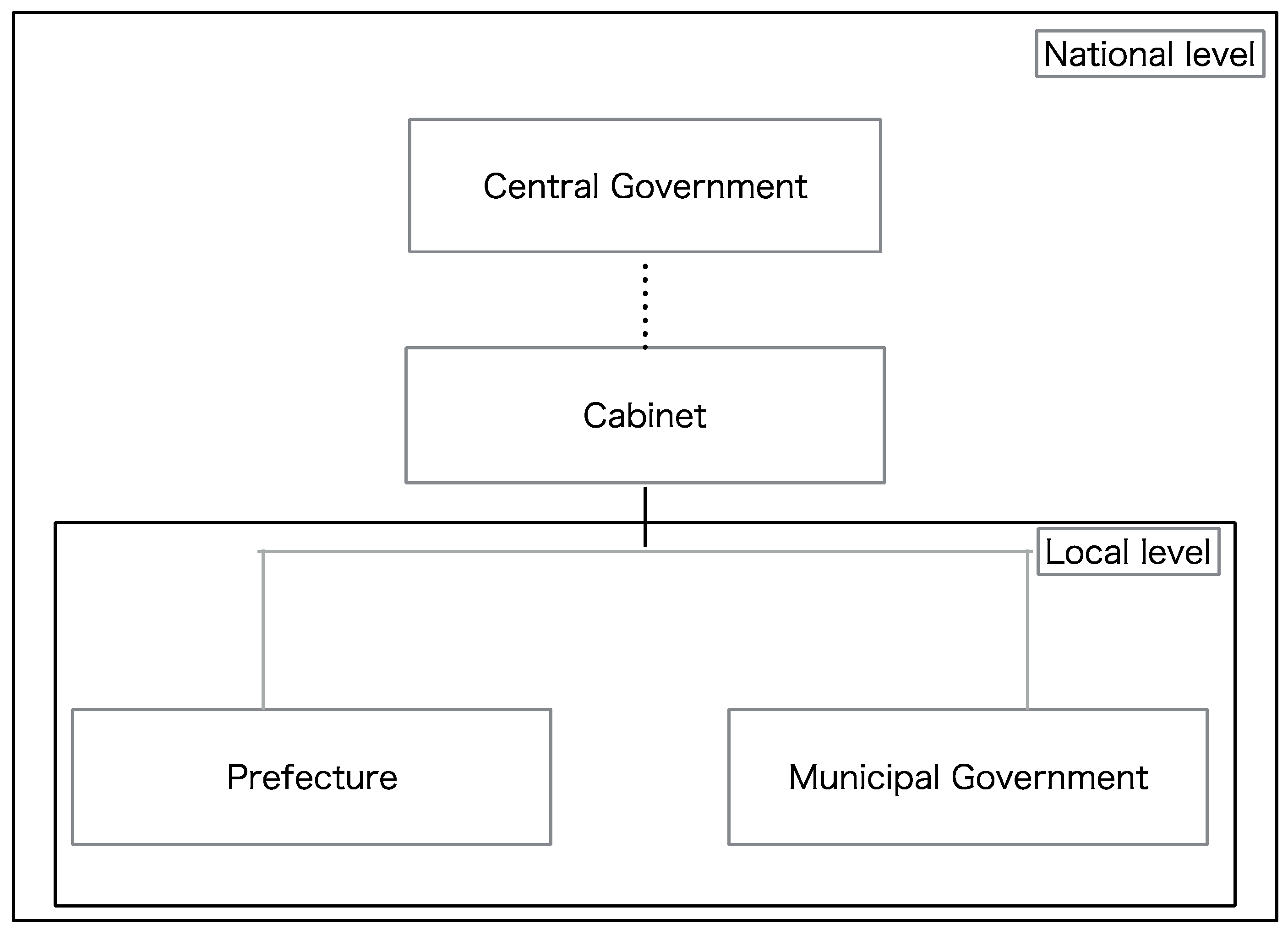1. Introduction
Groundwater is extremely important to all societies. It provides a reliable and ample supply of water in many places for home use, irrigation, and industry [
1]. In Japan, the law governing groundwater nationally is inadequately developed. We do not even have a water laws. We only have a river law and several other regulations (see
Section 4.2). Articles 13 and 25 of the Constitution of Japan about Life, Liberty, and the right to the pursuit of happiness provide the authority to build local ordinances for the conservation of sustainable ground water [
2]. They have become well-grounded articles in every groundwater conservation policy.
Groundwater has accumulated underground, seeping slowly through soil and rock, so that protecting the surface land is also essential. In recent years, water supplies have progressively depended upon groundwater, where access is comparatively easy and the water requires less stringent treatment than surface water. It is estimated that more than 1.8 billion people worldwide rely on groundwater to meet their daily water needs [
3]. In Japan, it gives about 12% of the total water consumption [
4].
In recent years, groundwater is facing new challenges. The Forestry Agency of the Ministry of Agriculture, Forestry, and Fisheries has published a press release in 2010, stating that there are active transactions in wasteland by foreign investors as well as by domestic investors, where land is covered by green forestland or paddy fields, an area that can recharge groundwater [
5]. This press release has received much attention from media all over the country, and people have had a good chance to reconsider how we can keep a local sustainable groundwater supply for future generations. In these circumstances, legislation and controls of groundwater are hotly disputed issues in Japan [
6]. It triggered controversy about natural conservation as well as the preservation of groundwater resources and influenced domestic issues by external factors. For example, in USA, most states’ surface water and groundwater have been placed in the public domain. Each state has its own local conservation and management system [
7].
There are not enough regulations to enact any local ordinances by local government itself. Consequently, a local government obeys local rules and the old tradition of sustainable groundwater conservation [
8]. Groundwater law, in Japan, has an “overlapping legal structure” [
9]. When an environmental problem, which is related to groundwater, results in a court action, then it appears at a glance that there are only a few laws for groundwater conservation. Other environmental laws cover the conservation of groundwater resources in a complex manner. This overlapping legal structure has been used for the natural preservation of groundwater.
However, no particular problems have so far occurred under these circumstances. If a difficult problem occurs in the future, it is not clear how we can protect groundwater resources without a groundwater law.
2. Geography and Climate
Japan is a spindle-shaped island country in East Asia comprised of a large stratovolcanic archipelago extending along the Pacific coast of Asia. Tokyo is a capital, where is situated at a latitude of 35°40’ N and a longitude of 140° E. Japan consists of several thousand islands, of which Hokkaido, Honsyu, Shikoku, Kyusyu, and Okinawa are the five largest [
10]. The population of Japan was estimated at 127,083,000 in 20 October 2015 [
11]. The population density in Japan is 343 people per km
2 [
11].
Because of the mountains running down the center of Japan, there is a large population in a narrow territory, and the precipitation per person is about one-third of the global average [
12]. The annual precipitation is 1690 mm, about twice the global average, which is estimated at 810 mm. Moreover, the precipitation per person is about one-third of the global average. The potential water resource per person is 3200 mm
3 per year, less than half the world average that is about 8400 mm
3 [
13]. Due to its location in the Asian Monsoon zone, the rainfall is concentrated in typhoon season [
14]. Most of the potential water resource flows into the sea without flowing into the ground. Japan has a mountainous typography with steep slopes and its rivers are short and flow rapidly out to the sea [
15]. Under these circumstances, a sustainable management of groundwater is indispensable.
3. Uses of Groundwater
Groundwater is more useful for supply and less vulnerable to pollution than surface water, and it constitutes about 12% of the total water consumption in Japan. Its temperature varies little through the year, so it is warm in winter and cool in summer. Groundwater is used to melt the snow on traffic routes and on roofs [
16]. Groundwater is used for tap water for industrial purposes such as the sake brewing industry, the cosmetic industry, the bottled water industry, the food industry, the hotel industry, public facilities,
etc. Figure 1 shows the percentage uses of groundwater in 2011 [
4]. About 30% is used for industry, 29% domestically, and 24% for agriculture; thus, when we discuss groundwater policy, the policy makers in Japan tend to give a higher priority to industry and agriculture [
17]. When a natural disaster occurs, groundwater becomes something necessary for survival [
18]. For example, at the time of the Great East Japan Earthquake in 2011, and the Great Hanshin-Awaji Japan Earthquake in 1995, many people survived by drinking groundwater from a community well in the neighborhood until a rescue team arrived [
19].
4. Water Governance
Groundwater is often considered as an unseen and therefore inexhaustible resource. In fact, it is often a fragile resource susceptible to pollution and over-extraction. Thus, it is essential that the government have a sustainable groundwater policy.
The Japanese government is responsible for formulating and implementing a water policy at a national level ([
21], pp. 1–6) in which the ministries of Land, Infrastructure, Transport, and Tourism play a central role. The ministries prepare a comprehensive plan for the development and conservation of water resources, for example, by making a plan for dam construction, building irrigation drainage, river management,
etc. On the other hand, the local government takes charge of the operation within the framework of the national policy. However, there is an exception in the local groundwater policy. Local government has been conserving its own groundwater resource independently by using local ordinances. This is discussed in the next chapter.
4.1. Organizational Structure
The national government formulates and implements comprehensive policies: The development of water resources, the administration of waterworks, and the protection of water quality. There are five related ministries to take charge of the various administrative areas, and cooperate with each other to formulate policies. They are (1) the Ministry of Land, Transport and Infrastructure; (2) the Ministry of the Environment; (3) the Ministry of Health, Labor and Welfare; (4) the Ministry of the Economy, Trade and Industry; and (5) the Ministry of Agriculture, Forest and Fisheries [
21].
Figure 2 shows the role of relevant government office related to groundwater.
The local governments manage the domestic, industrial, agricultural, and sewerage water utilities and their related facilities. The percentage of the national population with access to water resources reached 97.7% in 2015 ([
22], pp. 1–8). The local environmental division in each region continuously monitors the quality of public water and supervises local private companies to ensure that the standards for wastewater effluents are being met to prevent any environmental pollution caused by the effluent from factories [
23].
4.2. Legal Framework of Groundwater Policy
The legal framework for groundwater management in Japan is divided into two parts: (a) the national level; and (b) the local level,
i.e., local groundwater ordinances, regulation, rules, and old traditions [
24]. On the other hand, water laws are divided into four parts: (a) Laws related to hydrology (
Figure 3); (b) laws related to water uses (
Figure 4); (c) laws related to groundwater quality preservation (
Figure 5); and (d) laws related to groundwater research and development (
Figure 6).
4.3. Overview of National Law Related to Groundwater Policy
There is no law, which could be called the “Groundwater Law”, that is written about the comprehensive and fundamental principles of groundwater, whereas many separate laws have been established in order to govern groundwater operation, management, and conservation [
20].
These laws related to the use and conservation of groundwater consist of a strong arachnoid network. It is a complicated composition, but this system has been quite effective at the different levels of laws. The first priority in understanding groundwater is from the national laws. At the next level, there are many water laws by special classification. If there are not enough rules under those water laws, then local rules cover their limitations for natural conservation. There is also the general basic principle in understanding groundwater policy under Japanese law, as we shall see in the next paragraph.
Figure 7 shows the basic framework of the Japanese government. An ordinance is made by a prefecture and the municipal government; this is called the local level in this paper.
5. Groundwater: Legal Basic Framework and Ordinance
Local ordinances usually codify the laws of a political division, which is smaller than a state, such as a prefecture or a municipality. Ordinances are enacted by any prefecture or municipality under the authority granted by Article 94 of the Constitution of Japan.
Article 94 (Local Self-Government)
Local public entities shall have the right to manage their property, affairs, and administration and to enact their own regulations within the laws.
Ordinances must generally be approved by a local assembly, and promulgated by a city mayor or a prefectural governor, who may demand a second vote, but may not veto the ordinance.
It may impose a penalty of up to two years imprisonment and/or a fine of one million yen, although any penalty under an ordinance must be prescribed in accordance with the Code of Criminal Procedure, which is written in the local autonomy law. Some ordinances are banned on undeclared land transactions where they are closely connected with groundwater preservation. The expected benefit is deterring the overharvesting of groundwater.
6. Local Self-Government
The local authority relies upon parliamentary democracy and upon the theory of the separation of political powers; hence, the principle of local self-government is fully appreciated. It is said that “local self-government functions as an elementary school for democracy”. Ashibe states that it is significant that the decentralization of power would suppress the strength of the centralization of administrative power [
1]. The constitution of Japan in the Meiji era had not provided for local authority with the law. The definition of local authority at that time was the direct administration by the local government. In contrast, the Constitution of Japan established after World War II provided for the right of “local self-government”. The guarantee of this right did not mean natural or inherent rights, which are defined as a right held by a human being; hence, it is understood that local self-government is guaranteed for reasons of institutional security as a historical and traditional system.
7. Local Ordinance by the Constitution of Japan
The general principal of local self-government is described in Article 92 of the Constitution of Japan:
Article 92 (Local Self-Government)
A law in accordance with the principle [sic] of local autonomy shall fix the regulations concerning the organization and operation of local public entities.
“The principal of local autonomy” has two meanings: (1) resident self-governance and (2) self-governing body. It is independent of the national assembly.
Local government takes its responsibilities and duties from the principles of decentralization and liberalism. As quoted earlier, “Local public entities shall have the right to manage their property, affairs, and administration and to enact their own regulations within law” (Article 94 of the Constitution). Therefore, to make such a self-governing body, a local assembly or an advisory committee is a right given by the Constitution of Japan.
Article 93 (Constitution)
The local public entities shall establish assemblies as their deliberative organs, in accordance with law.
2. The chief executive officers of all local public entities, the members of their assemblies, and such other local officials as may be determined by the law shall be elected by a direct popular vote within their several communities.
Article 95 (Constitution)
A special law, which is applicable only to one local public entity, cannot be enacted by the Diet without the consent obtained in accordance with the law of the majority of the voters of the local public entity concerned.
The people’s right might demand that the local parliament be dissolved, because there is a right to vote in a public, political election, which shall be recognized as local government referendum (specified by local autonomy law).
8. Local Ordinance by Local Autonomy Law
A local ordinance is the right of self-government by a local public body described by the local autonomy law. This chapter shows the general legal framework of local self-government and the power to enact the regulations under the law.
Article 2 (Local Autonomy Law)
Each local public body shall be considered as a legal person.
2. Each ordinary local public body shall perform its own community affairs and the other affairs devolving upon itself by law or by cabinet order duly authorized in law.
Local public entities are given the right to manage their own property, affairs, and administration and to enact their own regulations within the law (see Article 94, the Constitution of Japan). Hence, the purchase of a catchment area for its groundwater by a foreign capital investment company in Japan may be one of the causes of a special regulation such as the enactment of Niseko Groundwater Ordinance in 2011. This action raised the environmental awareness and triggered public controversy [
25]. Each ordinary local public body shall determine its own community affairs by ordinance according to Article 2 of the local autonomy law. The local government is authorized to provide a new framework for groundwater conservation by law.
Practically speaking, the meaning of local government enactment is explained by Article 15 and 138, Section 4 of the local autonomy law.
Article 15 (Local Autonomy Law)
The chief executive of an ordinary local public body shall have the power to enact a regulation on any subject within the scope of his/her powers, insofar as it is not in conflict with law.
Article 138, Section 4 (Local Autonomy Law)
There shall be established by law, in addition to the chief executive, commissions or commissioners as executive organs of the ordinary local public body.
2. Commissions of an ordinary local public body may issue rules and other regulations, within the law or bylaws or rules of the ordinary local public body.
3. An ordinary local public body may, in accordance with law or bylaw, attach to any executive organ local disputes management commissioners, inquiry committees, examination committees, investigation committees, or other organs for the purpose of arbitration, inquiry, consultation, or investigation. This provision shall not be applicable to the executive organs specified by cabinet order.
Formally speaking, Article 2, paragraph 2 of the local autonomy law is a basic principle for the enactment of ordinances (see also Article 14 and 96):
Article 2, para 2. (Corporate Status and Affairs of Local Public Bodies)
Each ordinary local public body shall perform its own community affairs and the other affairs devolving upon itself by law or by cabinet order duly authorized by law.
Article 14 (Bylaw)
Each ordinary local public body shall have the power to enact a bylaw on any subject covered in paragraph 2 of Article 2, insofar as it is not in conflict with law.
2. Each ordinary local public body shall be able to impose duties or restrict rights only by law, unless otherwise prescribed by law.
3. An ordinary local public body may include in its bylaw penal provisions consisting of the imposition of imprisonment with or without hard labor not exceeding two years, fine not exceeding 1,000,000 yen, detention, minor fine, confiscation or administrative fine not exceeding 50,000 yen for a violation of its bylaws, unless otherwise specified by law.
Article 96 (Powers)
The assembly of an ordinary local public body shall by resolution:
enact, amend or abolish bylaws;
fix the budget;
authorize the settlements of accounts;
fix the levy or collection of local taxes or the collection of assessments, charges, initial charge or fees, except as provided for by laws or by cabinet orders duly authorized by laws;
authorize such contracts as may come under the scope prescribed by bylaw pursuant to the standards established by cabinet order with respect to the purpose and the amount of money involved;
authorize the barter, investment or offer as a means of payment, or cession or lease without compensation of the public property, except in cases provided by bylaws;
property to be left in trust;
authorize the procurement or disposition of such public properties as may come under the scope prescribed by bylaw pursuant to the standards established by cabinet order with respect to the category and the value, except as provided above;
accept contributions or donations;
renounce any right, except in those cases provided by laws or cabinet orders duly authorized by laws or bylaw;
confer the exclusive right to use important public facilities that are specified by bylaw for a period longer than that prescribed by bylaw;
authorize the compliant (appeal for reviewed), lawsuit, settlement, mediation, conciliation or arbitration in a case where the ordinary local public body is a party;
fix the indemnity legally due thereto;
exercise overall adjustment of the activities of various public organizations within the area; and
perform otherwise such affairs as may come under the powers thereof by laws or by cabinet orders duly authorized by laws (including bylaw duly authorized by laws or cabinet orders).
Ordinances are intended to regulate only the general affairs of the autonomous local government. Local registration has nothing to do with the national law as a general rule, although a local self-government body is able to pass independent regulations.
9. Niseko’s Groundwater Conservation Ordinances Example
The town of Niseko once pointed out in a press release that the Groundwater Conservation Ordinance would come into force on 1 September 2011 [
6]. This was a strong initiative by the municipal authorities to protect its own local drinking water [
22]. The town hall specified a large area of land to be preserved in its natural state as public property [
26]. The ordinance calls for the efficient utilization and equitable access and sharing of the region’s water resources to ensure a sustainable social, environmental, and economic benefit for all. The key principles of Niseko’s Groundwater Conservation Ordinance are summarized below:
This ordinance is based on the principle of the Niseko Environmental Basic Ordinance (Niseko Ordinance No. 29, 2001). The main intention is the control of water pollution and drought, and to authorize some natural conservation areas in and around the source of drinking water. Protecting the irreplaceable groundwater for the future will be a great contribution to the health and culture of the local people (Article 1).
The responsibility of the town council is to protect the sustainable social, environmental, and economic benefits of groundwater, and especially to protect citizens from hindrance in their life, and to pursue a groundwater policy (Article 3). The responsibilities of water users are to recharge groundwater, to reducing water use, and to cooperate with the local authority in the management and in the policy of sustainable groundwater (Article 4). People cannot excavate groundwater without permission from the headman of the town.
For example, one cross section of pump’s exhaust slot should be over 8 cm2. If someone shall change the position of pipe strainer, or expand the pump’s exhaust slot, then s/he must ask the permission of the headman of the town. The headman will not grant permission to water users unless they satisfy the conditions of the licensing standards written in Article 6. Before the government or other local public bodies agree to utilize the groundwater of Niseko, the headman of the town must agree that it is permitted under Article 1. The town headman has the authority to add additional qualifications or conditions upon water users if s/he deems that it is necessary (Article 5).
There are four main licensing standards in groundwater conservation: (1) It shall not impede an efficient water supply for the citizens; (2) It shall not have a negative effect on the existing system of the source and supply of water; (3) The use of the water should be necessary and be consistent with sustainability; and (4) It should agree that there is no alternative (Article 6). The applicant must explain the plan of the installation work in a meeting for the local residents. This meeting should be announced to the public within 10 days beforehand and notified by letter to the town headman. The applicant must report the results of the meeting to the town headman without delay. When the plan is disputed, the applicant must reach an agreement with the local people (Article 7). An applicant shall submit an application to the town headman with the following information: the name of the authorized representative, the name of the company, the purpose for which the groundwater will be used, the position of pipe strainer, the kind of pump, the cross section area of the exhaust slot, the average quantity of water to be pumped per day, the location of the well given with a map, and any other information that the town council may require (Article 8). After the town hall has accepted the application, the town headman shall discuss it with the Niseko committee responsible for the source of the groundwater (Article 9). The town headman should announce his decision within 60 days according to the provisions of Article 8 (Article 10). After the completion of the well, a report must be submitted to the town council within 15 days who will conduct an inspection in the name of the town headman (Article 11).
The well must have a device for measuring the amount of water taken, and this amount must be reported to the town headman every month (Article 12). In the event a person inherits, borrows, or amalgamates it with their own well, a permitted well facility shall be succeeded to its status to a legal heir. People who inherit as the legal heir a permitted well facility, and people who borrow or amalgamate a well with their own well, shall report the changes within 30 days to the town headman (Article 15).
The license for the well shall be withdrawn: (1) When the business is closed; (2) If the water is NOT mechanically pumped; and (3) If its area of cross section has been reduced to less than 8 cm2. When the license expires, it shall also be reported to the town headman (Article 16). The town headman shall rescind the license granted to applicants who applied by deceitful or improper means. If a company uses groundwater without permission, the town council shall as a matter of urgency order a cut in the water intake after a warning has been given and it has been ignored for the specified time. (Article 17). The town headman shall order the administrative officers to enter and inspect the facilities if that is necessary (Article 18).
The town headman shall advise or guide licensors or deputies and recommend any necessary steps (Article 19). After the recommendation in Article 19, if licensors or deputies neglect their duties, the town headman may order the implementation (Article 20). When licensees or deputies obey the town headman’s recommendation in Article 18 or orders in Article 19, the administrative officers shall report the results of the examination to the town headman (Article 21). If any person does not obey the order under Article 20, then the town headman shall order the abeyance of the licenses (Article 22). Any person, who refuses the recommendation of Article 19, and the order of Article 20 without any justifiable grounds, shall be named in public (Article 23). Any person who refuses the orders given under the preceding paragraph of Article 17, 20, and 22 shall pay a fine not exceeding 500,000 yen (approximately €1 = 123 yen as of 15 April 2016.) Any person who neglects or forgets to notify the town manager within 15 days after the facilities are finished shall pay a fine not exceeding 300,000 yen. Making a false declaration or refusing, disturbing, or evading an on-the-spot investigation shall pay a fine not more than 300,000 yen (Article 25). This ordinance shall also apply mutatis mutandis to any act in violation of the preceding articles to any representative of juridical person, deputy, employees, and other workers (Article 26).
10. Conservation Strategies and Challenges in Niseko
As the melted snow flows into Niseko town, the rich forests utilize recharged groundwater such as sump and subsoil water. People could not live without the benefits of nature and have to use the limited water resources that they have carefully. The most notable regulatory features of the Niseko ordinance is the requirement of publishing one’s full name together with the penalties for failing to do so. It states that groundwater is a local common property. At the same time, it sends a strong message to protect local environments by levying a fine on the violators of the rules. This is a new approach compared with other ordinances from different regions. Most of the environmental problems are the result of the accumulation of tiny environmental day-by-day changes. Water policy must also be adapted to those environmental changes, no matter whether they are small or big. There is no doubt that the regional administrative authorities know the current environmental circumstances in their own area. They have the capacity to make a prompt response to the urgent environmental problems [
27]. These new kinds of ordinances have covered the lack of fundamental groundwater laws at a local level [
28]. Because the legal structure is not sufficient at present, local Japanese city or town councils have begun to make groundwater ordinances for water conservation in their own community. For example, there is the Niseko Groundwater Conservation Ordinance, the Fukushima City Groundwater Conservation Ordinance, the Environmental Pollution Prevention Ordinance, the Suzuka city Drinking Water Conservation Ordinance,
etc. The number of ordinances total 517. They are complimentary to each other. Another example is the combination of the Niseko Groundwater Conservation Ordinance and the Hokkaido Groundwater Conservation Ordinance [
29,
30]. The Niseko town is located in the Hokkaido prefecture. The jurisdiction of the Hokkaido Groundwater Conservation Ordinance includes the entire Hokkaido area. Thus, when the Niseko Groundwater Conservation Ordinance could not prevent natural destruction by a land developer, the Hokkaido Groundwater Conservation Ordinance was perfect for conserving the local groundwater. When we think about preserving local water, we need to be flexible in our approach. Water supply and demand should be in a one-to-one ratio. A voluntary member of the House of Representatives and the House of Councilors published ideas in a press release for establishing a new fundamental groundwater act. Japan needs new national groundwater law, which can combine the national and local laws to ensure sustainability in the management of groundwater. We believe that children should inherit a sustainable system for managing groundwater. Policy makers and stakeholders must continue to find ways of preserving the water environment [
31].
11. Discussions
11.1. Capacity of Local Ordinance
The rights of local authorities to make laws are limited if an ordinance related to its own community and other affairs constrains a basic human right. Japan recognizes the right to have water at a community level. Historically, rice farmers have moral ties on water conservation for irrigation [
32]. Therefore, the limitations of private property rights to groundwater could not immediately argue that it infringes on constitutionality.
Therefore, local public entities shall have the right to manage their property affairs and administration and to enact their own regulations within law. As a general rule, then, without any special commission, a local administration must enact their own ordinances within the law.
Municipalities have tended recently to enact both an ordinance of groundwater conservation and an ordinance for conservation of the catchment basin of groundwater in a policy of sustainable groundwater conservation management. They see this as the most democratic way for local people to protect their water, independently of national policy trends. Ordinances in various localities around Japan have also recently included some form of punishment. This is a first step in developing a social structure and a plan whereby local people are able to manage rural resources in accordance with local environmental policy. This overcomes the limitations of national policy in rural policy.
However, there is a limit to the effectiveness of local ordinances and this may give an impulse for a new model for the conservation of natural resources.
11.2. Limitation of Local Groundwater Ordinance
Sustainable water conservation has been discussed for a long time, ever since the Meiji era, when the emperor was restored to power. Groundwater has always been an important natural water resource, in addition to surface water. As explained above, there has been some recent controversy about a sustainable groundwater policy and management. The government has passed no fundamental groundwater law, and groundwater ordinances exist only at the local level. Municipal ordinances are considered to be the basic legislation for sustaining a regional environmental resource, because the River Act states that groundwater is public property, whereas civil law states that groundwater is private property. To understand the groundwater regulations in Japan, the common law must also be considered because it also addresses aspects of private property that bear on these concepts.
For example, in America, most states’ surface water and groundwater have been placed in the public domain [
7].
Over time, society has gradually changed its view that groundwater should be regarded as public property [
33]. For example, it is very difficult to divide water under someone’s land. As a consequence, groundwater is generally considered as public property as per the old tradition, which is expressly acknowledged in common law.
12. Conclusions
This paper described the legal framework of the related local groundwater policy and regulations under Japanese law. In conclusion, the existing legal structure is adequate as a whole, to ensure the protection of groundwater. Existing laws oblige local administrations to protect and preserve the groundwater environment against social and climate changes. The case study of Niseko shows a good example of overlapping legal structure.
The complex legal systems have been discussed to understand the limitations of Japanese groundwater policy. Groundwater law is referred to as a “nested groundwater legal structure”, or an “overlapping legal structure”. Those laws are complementary to each other [
34]. At a glance, environmental laws are not enough for groundwater management; however, other laws cover the issues of environmental conservation. If those existing environmental laws do not preserve local groundwater, then the local groundwater ordinances cover alternatively the legal limitations on the protection of this source. The legal radical principle and its effects on groundwater conservation have proved that groundwater ordinances and related regulations have already given exact disciplines for natural conservation. The overlapping groundwater legal structures are unique aspects of the Japanese conservation policy. However, if an overlapping legal structure is no longer suitable for a change in social and/or environmental risk, it might be necessary to strengthen the legal structure of groundwater in the future.

